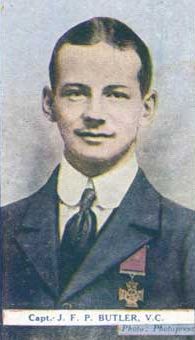 |
| St. Mary's Church, Berkeley |
The war memorial in Berkeley is the largest in the area, in terms of it remembering the names of the most men. This is despite its population in the 1911 census being notably smaller than both Cam and Dursley, suggesting that the 120 names it bears come not only from the town itself, but also from the surrounding parishes. This is corroborated by my research on Sharpness War Memorial which found that a large proportion of the men who were commemorated in the village were also commemorated in Berkeley.
 |
| The memorial shrine |
The memorial itself takes the form of a gilded shrine in St. Mary's Church which has an oak panel bearing the 120 names and is surrounded by wonderful paintings of St. Michael and figures of Peace and Justice. St. Michael, one of the two Anglican archangels, is believed to have fought against Satan and is the patron saint of the military, which explains his presence in the war memorial.
It is interesting that the town of Berkeley and the church specifically took both a religious and moral approach to the war memorial. For many, in the bereavement period after the Armistice there was a questioning on whether the war had been worth it, and indeed a confusion as to why it was fought at all. It is therefore curious that the memorial depicts Justice and Peace as tributes to the soldiers, but the memorial paintings are nonetheless beautiful and create a visual emotional response that many stone memorials do not.
 |
| The memorial plaque |
I won't reproduce the memorial list here as the
Roll of Honour website has already done so with a great amount of detail, but I will instead point out detail on a few of the men.
Among them, is Able Seaman John William Thomas, who was a staggering 59 years of age when he was killed in northern France on 30th December, 1917. Nominally, he had been serving with the Royal Naval Reserve, but due to the scale of the land conflict as the war progressed, Thomas' 63rd Division had been transferred to the British Army where he would have seen action at the Battle of Passchendaele and the Action of Welsh Ridge. In order to see service, he would have had to have lied about his age. This seems remarkable for a married man fifteen years above the age limit to have voluntarily enlisted in the war effort, but this is what Thomas did when he entered the Army Reserves in 1915.
It would of course be wrong to assume that he did this out of patriotism or valour. These may certainly have been factors, but so too might have been extreme poverty or an opportunity to avoid the workhouse or a criminal sentence. He was killed in action; his body missing, and is now remembered on the Thiepval Memorial to the Missing on the Somme.
One remarkable soldier was Captain John Fitzhardinge Paul Butler, who won both the Victoria Cross and the Distinguished Service Order within the first two years of the war. As the son of Lieutenant-Colonel Francis Paul John Butler, he had been raised in a military family and had attended Sandhurst for officer training before the war. He had been deployed with the King's Royal Rifle Corps in Africa as a Sergeant since 1913 and won his Victoria Cross for action in the German colony of Cameroon on 17th November, 1914. His citation in the London Gazette read as follows:
"With a party of 13 men, he went into the thick bush and at once attacked the enemy, in strength about 100, including several Europeans, defeated them, and captured their machine gun and many loads of ammunition. On 27th December, 1914, when on patrol duty, with a few men, he swam the Ekam River, which was held by the enemy, alone and in the face of a brisk fire, completed his reconnaissance on the further bank, and returned in safety. Two of his men were wounded while he was actually in the water".
 |
| The VC memorial, Berkeley |
By the following spring he had been promoted to the rank of Captain and in June 1916 he was awarded with the Distinguished Service Order for further bravery in the field. He died just three months later from wounds sustained in the first East African battle and is buried in modern-day Tanzania: a world away from the Gloucestershire he left behind. Since the centenary of his death, he has also been remembered on a paving stone in Berkeley's Market Square (between the old Natwest building and the bicycle rack).
(L-R) Parnell's memorial, and the young lieutenant in uniform
To the left of the war memorial as you look at it, is a private family memorial to John Atherton Parnell Parnell (yes, his surname is repeated). This ornate plaque is one of a pair, with his father who died in 1914 remembered to the left of John, who died only two years later. He was killed in action on 8th October, at High Wood in the latter stages of the Battle of the Somme while serving as a lieutenant in the 1st Battalion of the Gloucestershire Regiment. This was a notably bad day for the battalion, with a high casualty rate suffered while they attacked the west of the wood in preparation for a tank attack the following week. Parnell had been educated at Magdalen College, Oxford from 1913 but upon the outbreak of the war he had been transferred to Sandhurst for military training. He was 21 at the time of his death.
Kathryn
PS. There are a number of military graves in the town cemetery which I will write about on the blog next week and will then link here.









No comments: